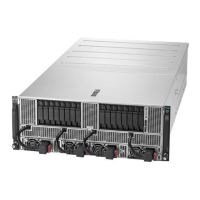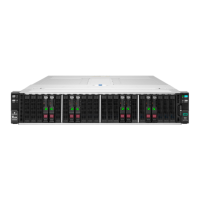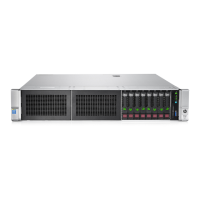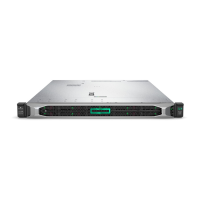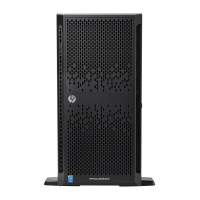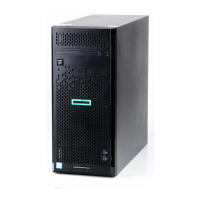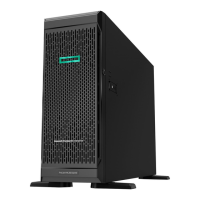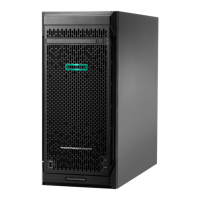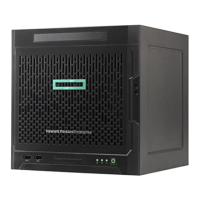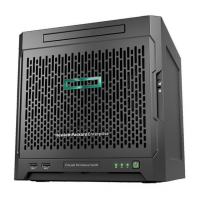Do you have a question about the HPE Apollo 4200 Gen10 Plus and is the answer not in the manual?
Details warranty service providing replacement parts free of charge.
Identification and diagrams of server mechanical parts.
Identification and diagrams of server system components.
Identification and diagrams of server optional components.
Lists tools needed for maintenance and replacement procedures.
General safety guidelines and precautions for performing service procedures.
Steps for safely powering down the server before maintenance.
Procedure for extending the server from its rack for access.
Procedure to remove the server's front bezel.
Warnings and precautions for extending the server from the rack.
Procedure for safely removing the server from the rack.
Procedure to open the access panel to access drive cage 3.
General guidelines for removing and replacing SAS, SATA, or NVMe drives.
Procedure for removing a hot-plug drive from drive cage 1.
Procedure for removing a fan from the rear of drive cage 2.
Procedure for removing the drive backplane from drive cage 3.
Procedure for removing and replacing the NVMe OS boot device.
Overview of UEFI System Utilities for system configuration.
Configuration options for UEFI and Legacy BIOS boot modes.
Information and configuration for Secure Boot security feature.
Procedure for launching the preboot command-line environment.
Information on registering for and using HPE Insight Remote Support.
Overview of the HPE InfoSight portal for server monitoring and analytics.
Details on USB support, including external USB functionality.
Identification of front panel components like ports and LEDs.
Description of status indicators and buttons on the server's front panel.
Table detailing LED behavior for power fault codes.
Identification of rear panel components and their status LEDs.
Identification of components located on the server's system board.
Information on the numbering and arrangement of DIMM slots.
Guide to interpreting DIMM labels for characteristics and specifications.
Explanation of the functions of system maintenance switches.
Procedure to disable the HPE SR100i Gen10 Plus Software RAID.
Diagrams and explanations of drive cage and drive numbering schemes.
Definitions and status of LEDs for LFF and SFF drives.
Identification of connectors on drive cage backplanes.
Identification of storage controller components and their connectors.
Definitions of fault LED status for NVMe OS Boot Devices.
Details on operating and non-operating temperature and humidity ranges.
Information on temperature ranges and altitude derating for operation.
Physical dimensions and weight specifications for server configurations.
Information on the types of power supplies used in the server.
Videos specific to procedures for drive cage 3.
Videos for common replaceable parts like power modules and adapters.
Information on how to contact HPE for live assistance and documentation.
Guidance on obtaining software updates for the server.
Information on HPE's remote support services and registration.
Links to warranty details for various HPE server and storage products.
Information on chemical substances, environmental, safety, and compliance data.
Details warranty service providing replacement parts free of charge.
Identification and diagrams of server mechanical parts.
Identification and diagrams of server system components.
Identification and diagrams of server optional components.
Lists tools needed for maintenance and replacement procedures.
General safety guidelines and precautions for performing service procedures.
Steps for safely powering down the server before maintenance.
Procedure for extending the server from its rack for access.
Procedure to remove the server's front bezel.
Warnings and precautions for extending the server from the rack.
Procedure for safely removing the server from the rack.
Procedure to open the access panel to access drive cage 3.
General guidelines for removing and replacing SAS, SATA, or NVMe drives.
Procedure for removing a hot-plug drive from drive cage 1.
Procedure for removing a fan from the rear of drive cage 2.
Procedure for removing the drive backplane from drive cage 3.
Procedure for removing and replacing the NVMe OS boot device.
Overview of UEFI System Utilities for system configuration.
Configuration options for UEFI and Legacy BIOS boot modes.
Information and configuration for Secure Boot security feature.
Procedure for launching the preboot command-line environment.
Information on registering for and using HPE Insight Remote Support.
Overview of the HPE InfoSight portal for server monitoring and analytics.
Details on USB support, including external USB functionality.
Identification of front panel components like ports and LEDs.
Description of status indicators and buttons on the server's front panel.
Table detailing LED behavior for power fault codes.
Identification of rear panel components and their status LEDs.
Identification of components located on the server's system board.
Information on the numbering and arrangement of DIMM slots.
Guide to interpreting DIMM labels for characteristics and specifications.
Explanation of the functions of system maintenance switches.
Procedure to disable the HPE SR100i Gen10 Plus Software RAID.
Diagrams and explanations of drive cage and drive numbering schemes.
Definitions and status of LEDs for LFF and SFF drives.
Identification of connectors on drive cage backplanes.
Identification of storage controller components and their connectors.
Definitions of fault LED status for NVMe OS Boot Devices.
Details on operating and non-operating temperature and humidity ranges.
Information on temperature ranges and altitude derating for operation.
Physical dimensions and weight specifications for server configurations.
Information on the types of power supplies used in the server.
Videos specific to procedures for drive cage 3.
Videos for common replaceable parts like power modules and adapters.
Information on how to contact HPE for live assistance and documentation.
Guidance on obtaining software updates for the server.
Information on HPE's remote support services and registration.
Links to warranty details for various HPE server and storage products.
Information on chemical substances, environmental, safety, and compliance data.
| Form Factor | 2U |
|---|---|
| Number of Memory Slots | 32 DIMM slots |
| Remote Management | HPE iLO 5 |
| Processor | Intel Xeon Scalable Processors (3rd Gen) |
| Memory | DDR4 |
| Storage | SAS, SATA, NVMe |
| Network | FlexibleLOM, PCIe stand-up cards |
| Power Supply | 1600W |
| Drive Bays | Up to 28 SFF or 16 LFF drive bays |
| Expansion Slots | Up to 8 PCIe 3.0 slots |
| GPU Support | Yes, supports GPUs |
| Operating System Support | Windows Server, RHEL, SLES, VMware |

